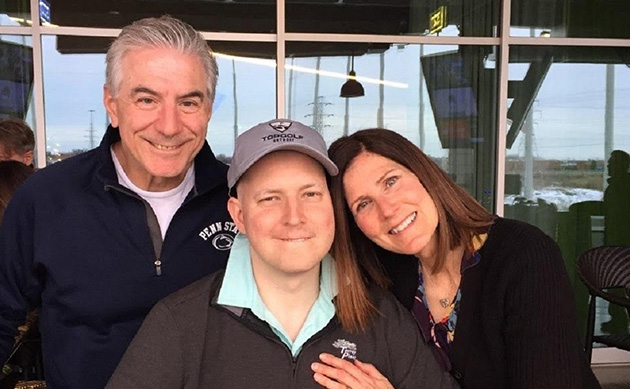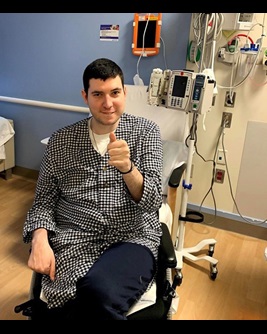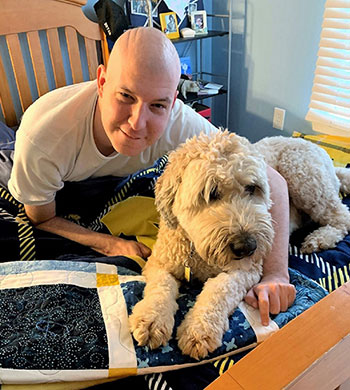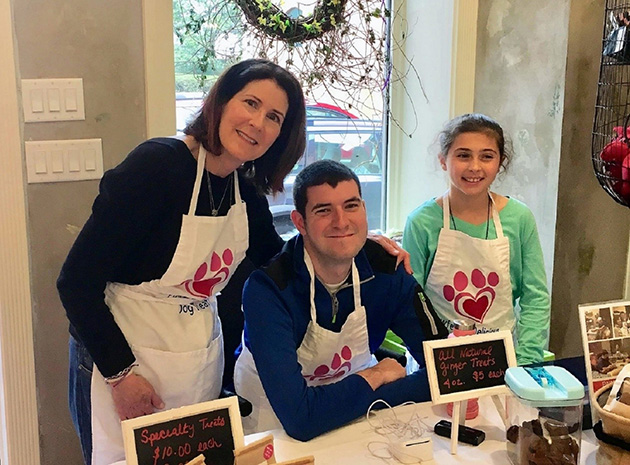Patient Story
Testicular Cancer: Bryan’s Story

Patient Story Highlights
- At age 27, Bryan Tuccillo, a Virginia resident with Leigh syndrome, was diagnosed with testicular cancer that had spread to lymph nodes in his abdomen, chest and neck.
- When the cancer did not completely disappear after chemotherapy, Bryan’s family sought help for him at Johns Hopkins, where surgeons removed cancerous tumors from his abdomen and neck.
- As his care team continues to monitor him for recurring cancer, Bryan is reclaiming his life and working at his family’s new nonprofit.
In April 2019, Bryan was complaining of back pain after a fall on the driving range where he works. It got so bad, he had trouble walking. Bryan and his mother, Anne, figured the pain was caused by the fall and would get better in time.
But by May, Bryan’s pain had worsened. He was exhausted and running a fever. “I felt like my body was shutting down,” he told Anne.
Bryan’s primary care physician requested a computed tomography (CT) scan, which revealed inflamed lymph nodes in the retroperitoneum (the area behind the peritoneum, which lines the abdominal wall and covers most of the organs in the abdomen), near the aorta and vena cava, the largest blood vessels in the body. A biopsy of those lymph nodes revealed mixed germ cell testicular cancer. Further imaging revealed that the cancer had advanced, spreading to the lymph nodes in the retroperitoneum, chest and upward into Bryan’s collarbone (clavicle).
That August, Bryan underwent radical orchiectomy surgery to remove his left testicle, and started four rounds of combination chemotherapy with etoposide and cisplatin, a tough regimen. He experienced nerve pain in his feet, but stayed the course, with the support of a large and loving network of family and friends. His mother, Anne, is one of 11 children, and her siblings’ kids stepped up to help their cousin through the grueling treatment.
Even with all the support, Anne and her husband, Bob, were worried. But they kept their hopes up; they’d seen Bryan’s resilience carry him through other tough moments.
Strength in the Face of Challenges
Bryan had already gone through a lot in his 28 years of life. When he was 4 years old, he was diagnosed with Leigh disease, a genetic disorder that affects the energy-providing mitochondria in his cells. The disease affects Bryan’s nerves and makes it difficult for him to walk and move around. Anne says the pediatrician told her that her baby boy was not likely to survive to age 10.
But with large measures of love, luck and care, Bryan reached adulthood and grew into a gentle, cheerful young man who makes an impression on everyone he meets.
Bryan was also born with an undescended testicle (cryptorchidism), which is associated with a higher risk of testicular cancer. The sooner cryptorchidism is treated, the less impact it has on cancer risk. But even when the problem is fixed in a timely manner, people born with a cryptorchidism are at a higher risk for testicular cancer throughout their lifetime.
Anne is passionate about educating others about testicular cancer risk factors. “There is a need to raise awareness,” she says. “Testicular cancer does not have a regular test that can help men get diagnosed and treated early, such as mammograms for breast cancer.
“Even though testicular cancer is a rare disease, it’s something that young men need to be aware of and discuss with their primary care doctors, especially if they were born with an undescended testicle.”
Consulting Testicular Cancer Experts at Johns Hopkins

After Bryan’s surgery and chemotherapy, his oncologist in Virginia recommended a positron emission tomography (PET) scan so the care team could assess the effectiveness of the treatments. While the cancer shrunk the cancerous lymph nodes, the scan revealed some lingering metastases in the retroperitoneum and collarbone.
The oncologist recommended that he seek treatment at a high-volume center for testicular cancer. Anne did her research and chose Johns Hopkins after watching a video of Phillip Pierorazio, M.D., director of Johns Hopkins’ testicular cancer division, in which he describes his approach.
Anne says, “In the video, Dr. Pierorazio says, ‘The moment a man is diagnosed with testicular cancer, he is a survivor of that disease,’ and he made a point of saying that he works as a team with the patient’s family. I knew we could count on him to follow Bryan, and that’s what made me reach out to him.”
Anne emailed Pierorazio in December 2019, and was surprised that he replied a day later. “I thought it would take forever,” Anne says, “But Dr. Pierorazio got right back in touch and we were able to set the ball in motion.”
Treating the Whole Patient
Anne says that when she, her husband and Bryan met with Pierorazio in early January 2020, they were immediately impressed with the doctor’s honesty and caring demeanor. “He was very straightforward with Bryan and the rest of us in the family. Doctors are kind of like priests; you have to be able to confide in them and feel comfortable. We were very scared, but we felt like we had the right person.”
Pierorazio and his peers handle all aspects of the disease, from open and robotic surgery of testicles and lymph nodes to prostheses, fertility concerns and other aspects of well-being. Pierorazio says that a typical course of testicular cancer treatment starts with the removal of the affected testicle (radical orchiectomy) and a microscopic examination of the cancer cells.
“Depending on the type of cancer we’re dealing with, we will order staging examinations, such as blood work, CT scans, chest X-rays and other tests that will help us determine the stage of the cancer and decide on treatment options,” he explains.
“There are good places and excellent places, and we were lucky to find ourselves in excellent hands.”
Anne, Bryan’s mother
For men newly diagnosed with testicular cancer, Pierorazio says that consulting with a group familiar with the disease is essential. “Not all urologists see and treat a lot of patients with testicular cancer because it is relatively rare,” he says. “It’s important that patients consult with experienced, high-volume centers.
“Even if you don’t stay with and get your treatment with them, it is worth it to get a recommendation for your treatment plan.”
Multidisciplinary Care to Address Testicular Cancer and Its Spread

Bryan, after treatment, relaxing with a pal
After examining Bryan, Pierorazio recommended a surgical procedure called retroperitoneal lymph node dissection, or RPLND, to treat the remaining tumors and offer Bryan the best chance to stay ahead of the cancer.
It is a daunting procedure, involving a large incision that runs the length of the patient’s belly. There is a less invasive version that uses a series of smaller incisions and can mean a shorter hospital stay and faster healing, but Pierorazio explains that option is appropriate for men with less-advanced cancer who have not gone through chemotherapy, as Bryan had.
Bryan’s RPLND surgery took place in March 2020. While most patients return home in three to five days, Bryan had a longer course of recovery.
Anne and Bob had to stay with him around the clock, since Bryan’s Leigh syndrome limited his ability to recover in the hospital on his own. Then, he experienced an intestinal shutdown (ileus), a common risk after major abdominal surgery and anesthesia. Bryan had to have a feeding tube inserted and remained in the hospital for 15 days. Anne and Bob brought him home March 18, right as things began to shut down due to the coronavirus pandemic.
“We got out just in time,” Anne says, “right as hospital staff were starting to remove chairs in waiting areas for physical distancing.”
Bryan returned in August 2020 so Pierorazio and William Burns III, M.D., could remove cancer that had spread to the area behind Bryan’s diaphragm. When tests picked up more cancer in the lymph nodes in Bryan’s neck, Pierorazio teamed up with a Johns Hopkins head and neck surgeon colleague, who performed the delicate surgery to remove the affected lymph nodes.
Bryan: ‘Reclaiming His Life’ with a New Career
Bryan’s follow-up includes careful, frequent monitoring. He gets checked for any signs of spreading cancer every three months, and continues therapy to address nerve issues in his neck after the lymph node removal. He has gone through physical and occupational therapy to improve his ability to walk, which had been set back by the major surgeries.
Anne understands the continuing vigilance. “They’re taking the cancer away bit by bit,” she says, “but it’s a sneaky disease. You can’t say it’s completely gone.”
Still, she knows her son, and his inner strength. “Bryan’s story is about resilience,” she says. “Cancer is not going to define who he is. He is reclaiming his life, for the most part. He doesn’t dwell on the future. He worries a little, but he is moving on, for now.”
Part of moving on involves a new career. During Bryan’s treatment, he, Anne and the family started a nonprofit dog treat bakery that provides job training for young people like Bryan who are living with disabilities.

Bryan and his family working at their dog treat bakery
Anne says, “All the inspiration for it came from Bryan. He embodies what's good in this world. He never complains. He gives back, and he is grateful.”
“I wanted to invite Dr. Pierorazio over for dinner so I could thank him for saving my life,” Bryan says.
Pierorazio says of his patient, “Bryan is one of the most unique patients I've ever cared for. He’s faced tremendous challenges and handles everything with grace, a smile and a positive attitude. He is kind and gentle and his family has been so supportive.”
Anne says her experience at Johns Hopkins showed her the importance of the relationship between patients, families and the care team, and how that has given her son the best chance for a good quality of life.
She says, “There are good places and excellent places, and we were lucky to find ourselves in excellent hands.”



